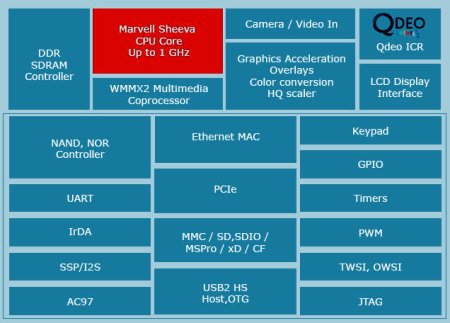DPF design runs Linux
Jan 12, 2009 — by Eric Brown — from the LinuxDevices Archive — 6 views [Updated: Jan 15, 2009] — Chumby demonstrated a WiFi-enabled digital photo frame (DPF) reference design developed with Marvell Semiconductor. The design combines Marvell's new PXA168 system-on-chip and WiFi chipset with Chumby's Linux-based “push” info-tainment stack and website, says Chumby.
[Updated: Jan 15, 2009] — Chumby demonstrated a WiFi-enabled digital photo frame (DPF) reference design developed with Marvell Semiconductor. The design combines Marvell's new PXA168 system-on-chip and WiFi chipset with Chumby's Linux-based “push” info-tainment stack and website, says Chumby.
(Click for larger view of a mockup of Chumby's Marvell PXA168-based DPF design)
The Chumby/Marvell hardware-software design is almost identical to another collaborative DPF design Chumby announced last week with Samsung, which is contributing its ARM11-based S3C6410 system-on-chip (SoC) to the picture-frame design. Like the Samsung collaboration, the Marvell design uses the same Linux-based software stack first used in Chumby's digital alarm clock. The Chumby device (pictured below, right) began shipping last February for $180, and features hackable, open-source Linux software, and even hackable hardware and “outerware.
 Chumby radio (Click for details) |
Like the Samsung-based DPF design, the Marvell design will offer access to Chumby services, content, and advertising. The Chumby Network offers over 1,000 Internet widget applications, including links to third-party content providers, as well as tens of thousands of Internet radio stations, say the companies.
The only difference between the Samsung and Marvell designs appears to be the use of Marvell's new PXA168 processor (see farther below), and the specific inclusion of a Marvell WiFi b/g chipset as opposed to a generic WiFi part. Both designs also specify components from STMicroelectronics and Wolfson.
The DPF design will operate at 1GHz and will exploit the PXA168's built-in support for Adobe Flash Lite media playback technology, says Chumby. Specifications are said to include:
- Processor — Marvell PXA168 at 1GHz with cryptoprocessor
- Memory — 128MB DDR2 SDRAM
- Flash — 2GB to 8GB NAND flash
- Flash expansion — card reader with support for CF, SD, MMC, MS, and XD memories
- Display — 8-inch 800 x 600-pixel touchscreen LCD with dimmable backlight
- USB — 1 x USB
- WiFi — Marvell WiFi b/g
- Audio — integrated speakers; mic input; headphone/line output
- Options — video camera; IR and ambient light sensor
- Video formats — MOV, H.264, AVI, MJPEG, MPEG-4, MP4; accepts On2 and Sorenson streaming, and YouTube
- Audio formats — iPod via USB and memory stick; Internet radio, including ShoutCast, RFC, Pandora
- Image formats — JPEG, GIF, PNG
- Power — +5V 2.5A; RTC with battery backup
- Operating system — Linux

Marvell/Chumby DPF reference design block diagram
(Click to enlarge)
Marvell's PXA168 was announced last week, targeting low-power devices that run Linux or Windows CE, and incorporate Internet connectivity, multimedia, and touchscreen interfaces. The SoC is based on Marvell's new “Sheeva” core technology, which is said to combine its previous Feroceon and XScale architectures, and is scalable beyond 1GHz. Providing full ARMv5TE and XScale compatibility, the SoC offers “extensive clock gating”, and uses a low-voltage 65nm process, says the company. The PXA168 provides L1 and L2 caches of unspecified capacity, and offers a direct path to both LP-DDR1 and DDR2 memory clocked up to 533MHz.

PXA168 block diagram
(Click to enlarge)
Marvell launches 802.11n chipset
Also last week, Marvell announced its 88W8786 single-stream 802.11n WiFi chipset, which is said to be designed for use in mainstream consumer devices. The 88W8786 chipset supports bit rates up to 150Mbps, as well supporting STBC and various aggregation schemes for increased range and robustness, says the company. Marvell did not state which operating systems it was supporting with the new WiFi chipset, but the company typically offers Linux support for its processors. The 88W8786 has been sampling since last summer, and should go into production later this quarter, says Marvell.
Availability
The Chumby/Marvell PXA168 DPF reference design is available from Chumby as an open-chassis evaluation kit, starting at $600, says Chumby.
This article was originally published on LinuxDevices.com and has been donated to the open source community by QuinStreet Inc. Please visit LinuxToday.com for up-to-date news and articles about Linux and open source.